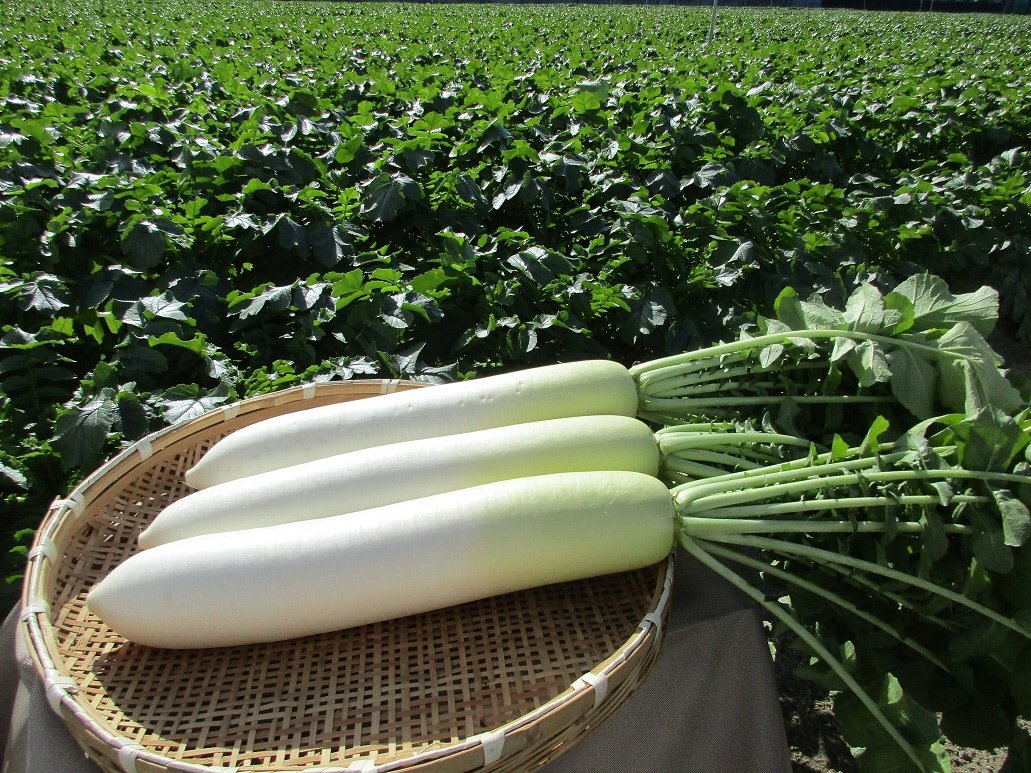Wakayama Nunohiki Daikon
| Registration Number | 108 |
|---|---|
| Name of the GI | Wakayama Nunohiki Daikon |
| Class | Vegetables/ Cereal grains/Pulses |
| Date of Protection | 2021/05/31 |
| Producing Area |
Wakayama Prefecture
Nunohiki, Uchihara, Kimiidera and Kemi Districts in Wakayama City |
| Applicant - Name and Address | JA Wakayama Kurusu 642, Wakayama City, Wakayama |
Producing Area
"Wakayama Nunohiki Daikon" is an aokubi daikon (a variety of Japanese radish)(1) produced in sandy soil in the producing area. Characteristically, the root has a consistent diameter from the top to bottom, few fibrous roots, very shallow dents around fibrous roots, and smooth skin. It is highly graded for its quality also by people in the marketplace and traded at a high price.
The variety used for "Wakayama Nunohiki Daikon" is selected by a variety test performed every year. The Daikon is cultivated within the producing area and harvested when it weighs "2L", which is the main class of "Wakayama Nunohiki Daikon".
For shipping, it must fulfill the following three standards:
1) no cavity within the root, 2) free of pest, insect, freezing or any other damage, and 3) no branched root, no root cracking, no injury, no rotting and no stain. Those from which parts not satisfying the above standards 2) and 3) have been removed are deemed to satisfy the shipping standard.
The sandy soil in the producing area has high air permeability, drains well and is soft, allowing oxygen to be supplied deep underground, and is thus adequate for cultivating Wakayama Nunohiki Daikon. Water management for growing the daikon is also easy in the producing area as there is the Kinokawa River (2) flowing nearby as well as plenty of underground water.
Mainly, producers were in charge of variety tests and deciding the proper season of harvest, but the tasks were transferred in 1999 to JA Wakayama, which has been thoroughly controlling them until present.
Historical records say that daikon was already cultivated in the area as a major crop at the end of the 17th Century (early years of Edo Period (3)). Kimiidera Temple (4) in the producing area serves dishes of "Wakayama Nunohiki Daikon" to visitors on December 18 every year since 2001.
The shipment quantity in 2019 was about 4,500t, and the number of farms was 50.
- Aokubi daikon currently accounts for the majority of "daikon (white radish)" distributed in Japan. It is characterized by having a slightly green root top, the part above the ground. It is also disease tolerant and easy to pull out.
- The Kinokawa River: It is a Class A river (length: 136km). The name comes from "Kii" province, the ancient name of the geographical region.
- The Edo Period: 1603-1867. It is a period of Japanese history characterized by the establishment of a shogunate (feudal military government) in Edo (now Tokyo). Political administration under the Tokugawa clan began when Tokugawa Ieyasu became the era's first shogun.
- Kimiidera Temple: It is located in Kimiidera, Wakayama City, Wakayama Prefecture. It is believed to have been founded in 770.


